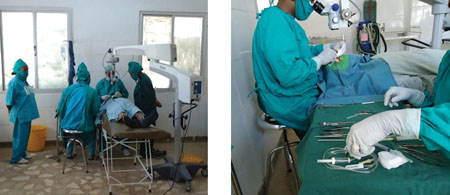5.2.4 Treatment of cataracts
The most important step in the treatment of cataracts is early detection of the problem. Once it is detected at the early stage, the initial treatment is to slow down the clouding of the lens by following the preventive measures described in the previous section. For late-stage cataract with blindness, the best intervention is surgical treatment to remove the cloudy lens (Figure 5.6).

Taking out the lens improves the person’s sight because light can get all the way to the back of the eye again. However, without a lens to focus the light, the restored vision is more blurred than before the cataracts developed. Cataract surgery may be available that includes replacing the cloudy lens with an artificial one, which restores good sight.
So, besides advocating and practicing the preventive measures, you have to facilitate transfer of people affected by cataracts to a hospital or health centre with an eye-care unit. You should tell the person you refer about the big transformation of life after the treatment of cataract blindness (Case Study 5.1), so that the person will decide on travelling for treatment. At times cataract operation campaigns may come to your village and you should take part in actively mobilising affected people in the community to come for treatment.
Case Study 5.1 Mr K had never seen his grandson
Mr K is 71 years old and has worked as a farmer all his life. His daughter recently gave birth to his first grandson, but he was very depressed when he realised that he cannot see the baby because he is blind from cataracts in both eyes. As a Health Extension Practitioner, you recognised several years ago that Mr K’s sight problems were due to his cataracts, but he would not take your strong advice to go to the health centre for assessment and possible treatment. When you went to his house for a visit after his grandson was born, you again encouraged him to travel for cataract surgery. This time he decided to go for treatment. The surgery was very quick and it did not cause him pain. The outcome was successful and when he came back to the village he prepared a big feast to celebrate his ability to see his new grandson.
Does this story help you in referring other people for cataract treatment? We hope that it does, as you know it is a great blessing for anyone to reach the age of having grandchildren and great-grandchildren. But being unable to see them is sad. When this disability is corrected by cataract surgery it is like being reborn. So, such a success story is useful in encouraging people to go for cataract treatment.
5.2.3 Prevention of cataracts
